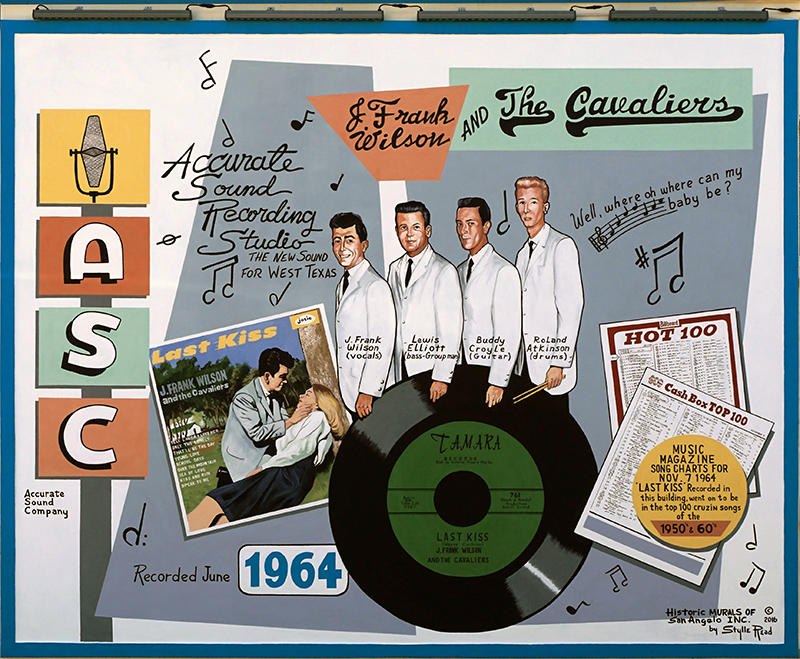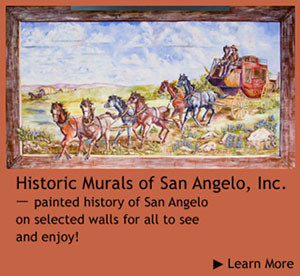|
The Cavaliers Mural

The sixties, imagine–music is fun. Fashion is funky, miniskirts, paisley shirts, cruising the strip, the space race, Vietnam, and Rock and Roll. Your new car costs $3,000, and gas is 25 cents a gallon. Route 66, Perry Mason, Rawhide, Lassie, and Flipper are your favorite TV shows. It is a time of possibilities, innocence, fun, hopes, and Rock n’ Roll dreams in San Angelo.
The 20-by-16-foot mural on the east side of the building at 15 N. Tyler St., designed and painted by renowned Texas muralist Stylle Read, captures the spirit of the 60’s. The inspiration for his mural was Accurate Sound Recording Studio, “The New Sound for West Texas,” and the hit record "Last Kiss,” by J. Frank Wilson & the Cavaliers which was recorded here.
In 1961, Ron Newdoll, began Accurate Sound Co. at this location and built a recording studio in the space downstairs in 1963. On a steamy, early summer evening in 1964, when hi-fi was just beginning, a local group of West Texas boys with big dreams, recruited a few girls who sang with a local church choir to sing backup, and recorded the soon to be million selling, No. 1 hit record “Last Kiss”. This recording group later became known as “J. Frank Wilson and The Cavaliers.”
Mr. Read’s mural depicts J. Frank Wilson, lead singer, Lewis Elliot, band leader and Bass, Gene (Buddy) Croyle, lead guitar, and Roland (Snake) Atkinson, drums, standing behind the “Last Kiss” single released by Tamara Records. Under the direction of their manager Sonley Roush, soon after recording, they were booked by the Morris Booking Agency in NY, and traveled with Dick Clark’s Caravan of Stars during the fall of 1964.
"Last Kiss" continued its climb to the top of the charts. The group toured, played local clubs, state fairs, state parks and made national TV appearances. They went on a nationwide tour with many 60’s entertainers including, The Animals, The Royalettes, and Elkie Brooks. They toured through Birmingham, Nashville, Philadelphia, New York City, Utica, Columbus, Rochester and many other major cities. The Cavaliers opened the show, backing The Royalettes. J. Frank Wilson took the stage with The Cavaliers, then The Animals would take the stage, riding high on the chart with their first American hit “The House of The Rising Sun". The Cavaliers and The Animals had a friendly rivalry and the bands shared the same tour bus. The Animals saw J. Frank Wilson perform "Bring It on Home to Me", and later recorded the song.
"Last Kiss" was #3 on the charts the last week of October when tragedy struck. In the early morning hours of October 23, Sonley Roush, J. Frank Wilson, and Bobby Wood (a Memphis recording artist for Joy Records) with Gene (Buddy) Croyle and Phil Trunzo in the back seat, were traveling from Parksburg, West Virginia to Lima, Ohio. The band was due to perform in Lima on the evening of the 23rd. Sonley was driving on Route 31, south of Kenton, Ohio, fell asleep at the wheel, and at 5:15 a.m. drifted left of the center, head on into a tractor trailer truck. Sonley was killed instantly, and all others were injured.
A week after the accident, the record was number 2, and then number one the week of November 7, 1964 (according to Cashbox Top 100 Chart) and is depicted on the far right side of Mr. Read’s mural. Amazingly, J. Frank would be back on tour within a week of the accident. J. Frank performed with the professionalism that made him famous. On the left side of the mural, Mr. Read has painted the “Last Kiss” album of songs released by Josie Records featuring J. Frank on the cover that sold over 100,000 copies the first few months. Accurate Sound Company’s original building logo is painted on the far left of the mural.
Although 1964 is best remembered for the year the British invaded the U.S. charts, this San Angelo group with big West Texas hearts and talent, invaded the music scene, achieving a million selling gold record for the song “Last Kiss”. It all began right here where you’re standing, and near the light pole where the guys stood on recording breaks, laughing, and deciding what kind of cars they would buy with their earnings if they made it big. This is where small town dreams began.
|



